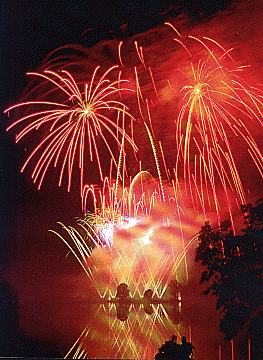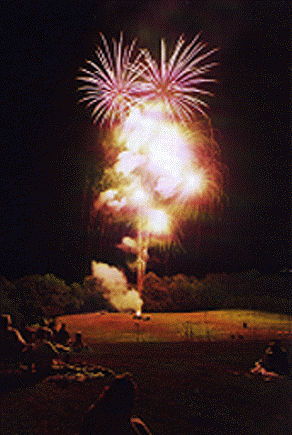
The Chemistry of Fireworks


 Chemical reactions
Chemical reactions
Oxidisers
Binders
Colour and colouring agents
Incandescence
Atomic Emission
Molecular Emission
The firework is most commonly recognised in
the form of a rocket. This, in it's most simple
form consists merely of a tube of rocket fuel,
sealed at one end, and with a constriction, or
nozzle at the other end. The fuel is burnt,
producing gases, which due to the lack of space,
and small nozzle, are forced out, propelling the
rocket away from the earth with an equal and
opposite force. There are normally further chemicals
and explosives in the nose of the rocket which
produce the spectacular effects we see.
These effects have been a familiar part of
celebrations for centuries, and for most of this time
designing fireworks was considered a craft, not a
science. It is only fairly recently that the term
pyrotechnics has emerged, as people have tried to
understand the chemistry and physics behind creating
these effects, in order that greater and more
spectacular fireworks can be created.
You can view some futher examples of these effects below:


About 1000 years ago, black powder, which serves as both the propellant and explosive
charge in most modern shells, was created by the chinese.
It's formula is a blend potassium nitrate, charcoal and sulphur in a 75:15:10 ratio by weight.
Black powder may be the only chemical product to have remained unchanged in terms of it's
ingredients, and proportions, indicating that it is nearly perfect for it's use in fireworks.
Indeed, that fact that it uses inexpensive chemicals that are fairly non-toxic, and that it can be
stored safely, without deterioration for several months due to the stability of the mixture,
illustrates it's suitability.
However, despite this, there has been further developments, and the black powder substitute,
Pyrodex is now being more
commonly used.
The burning of pyrothechnic compositions, is merely a combustion reaction. The composition must
contain an oxidiser and a reducing agent (the fuel). Other than black powder, a variety of fuels
may be used. Often,fuels contain organic materials, eg. charcoal or
thermite. Nonmetallic elements such as sulphur, silicon and boron are used as they produce
a large amount of energy when oxidised.
Metallic fuels eg. aluminium, magnesium and titanium are used, because when they burn they emit
a very bright light, which dramatically improves the brilliance of the firework explosions.
Atoms in the fuel lose electrons to atoms in the oxidiser. In the course of this process, the
fuel atoms form bonds to the oxygen atoms liberated from the oxidiser, forming more stable
reaction products. This process is exothermic.
Although a fuel-oxidiser mixture is relatively stable when cool and dry, only a moderate input
of energy is required to start combustion. Once started, there is a rapid release of energy, as
on ignition, the solid mixture begins to liquefy and vapourise in the flame, bringing the fuel
and oxidiser into close proximity, where reaction is more likely.
Return to top of page?
The most commonly used oxidisers are the perchlorates
in particular, potassium perchlorate, KClO4, which although expensive, is a very good oxidiser
and ammonium perchlorate. This chemical also has the added ability to enrich the colours of reds
blues in a firework. Blues are a particularly difficult colour to produce, so enhancing what
exists is very useful. The nitrates are also used, but potassium nitrate is relatively mild in
terms of its oxidising ability, and ammonium nitrate
is unstable, and therefore not safe enough to be used in fireworks that may be bought by the public.
Return to top of page?
Loose pyrotechnic powders are more likely to ignite, and therefore more dangerous than pastes.
As a sufficient amount of energy can be input in order to ignite the pastes, it is more
sensible to work with them in this state. Binders are therefore required.
The most commonly used is dextrin,a type of starch which holds the composition together,
although gum arabic and parlon are also used.
Parlon is particularly useful if trying to create red and green colours, as the compound required
for this are chlorides of barium and strontium. However, the compounds themselves are too unstable
to store in the firework, so the are created temporarily in the flame. Parlon, a chlorinated
isoprene rubber, is a chlorine donor, as it decomposes at high temperatures releasing free chlorine
Therefore, the chlorine can now combine with barium or strontium, producing the desired molecules.
Saran and Shellac are similar substances, although Shellac does have the advantage of
being non water-soluble, and can therefore be used where absorption of water would ruin the
composition.
return to top of page?
The region of the electromagnetic wave where visible light is produced, is between 380 and 780 nm.
A glowing object will appear white, if it radiates wavelengths across this region. If, however,
the object emits wavelengths which belong to a small portion of this region, we will see the
corresponding colour.
Pyrotechnic compositions emit light by three basic processes - incandescence (blackbody radiation)
atomic emission, and molecular emission.
Return to top of page?
This occurs when solid or liquid particles in the flame of the firework are heated to extremely
high temperatures. The hot particles release excess energy in the form of a broad spectrum of
radiation. The higher the temperature, the shorter the wavelength at which most radiation is
emitted, hence a trend towards the blue end of the spectrum, and the very bright white colours
that are sometimes seen, with the hint of blue enhancing the white.
The intensity of the emission is proportional to the fourth power of the flame temperature, hence
a moderate increase in the temperature dramatically brightens the flame.
White light flares contain reactive metals such as magnesium (mentioned earlier) as a fuel.
When the fuel is oxidised, the resulting metal oxide particles are heated to approximately 3000 degrees C.
Aluminium and potassium perchlorate, commonly known as flash powder
produces a powerful explosion, along with a burst of bright white light.
The larger the metal particles, the longer they retain their heat, and burn bt continuing to draw
oxygen from the air. White sparks are created, rather than one large flash.
Charcoal and iron particles only reach about 1500 degrees C - not as hot as the reactive metals,
and the result is dimmer, gold coloured sparks.
Return to top of page?
This process ocurrs when atoms in the flame absorb energy. This causes an electron in the ground
state orbital to be promoted to, a higher energy one. However, this is an unstable situation, and
the electron quickly falls back to its original orbital, remitting energy. This energy is
released as an electromagnetic wave, which happens to fall within some region of the visible
spectrum.
Return to top of page?
Similarly, molecular emission involves a transition from a ground state to and excited one, and
then from the excited state back to the ground state. Again, the molecule must be in the gaseous
phase, and the temperature must be sufficient to supply enough energy to cause it to radiate.
However, care must be taken, as if the temperature becomes too high, the molecule disintegrates
into its constituent atoms,and no visible light is seen. Moreover, care must be taken as to how
much of the substance is packed into the firework
-too little, and the colour is not intense enough to make a proper impact
-too much, and there will be too many particles in the flame, which would lead to incandescent
radiation which would wash out the colour.
Return to top of page?
Colour Producing Compounds
| Compound Name | Formula | Colour of Compound |
| Copper acetoarsenate | C4H6As6Cu4O14 | Blue |
| Copper(1)chloride | CuCl | Turquoise |
| Cryolite | Na3AlF6 | Yellow |
| Lithium Carbonate | Li2CO3 | Red |
| Anhydrous Strontium Carbonate | Sr(NO3)2 | Brilliant red |
| Barium carbonate | BaCO3 | Green |
| Barium chloride | BaCl2 | Bright green |
And Finally...
The last component to create a full firework is often sound in the form of a whistle.
Compositions containing potassium perchlorate oxidiser and an organic salt eg. sodium salicylate
burn one layer at a time, and emit gas in spurts. When such compositions are contained within
the narrow tubes of the firework, the rapid pulses of escaping gas produce the whistling sound.




